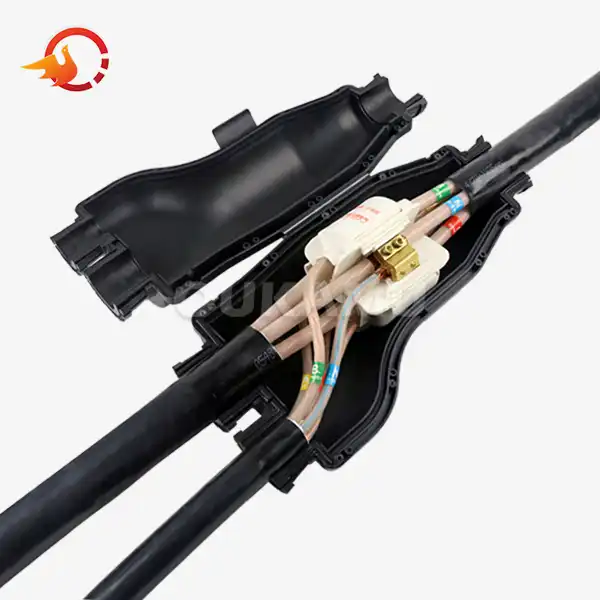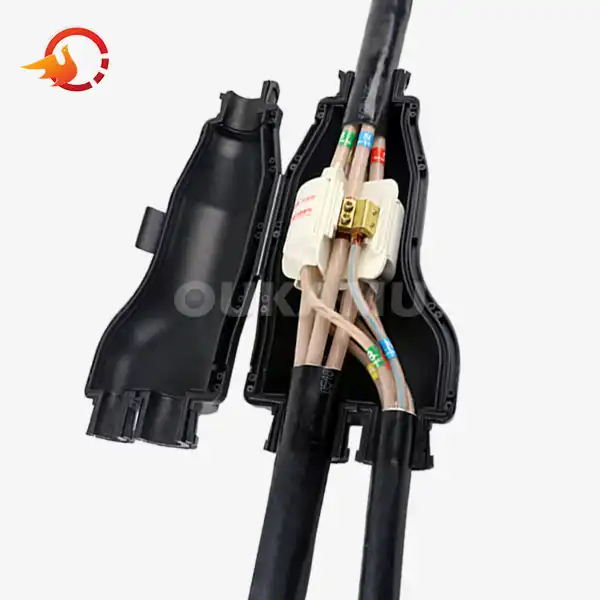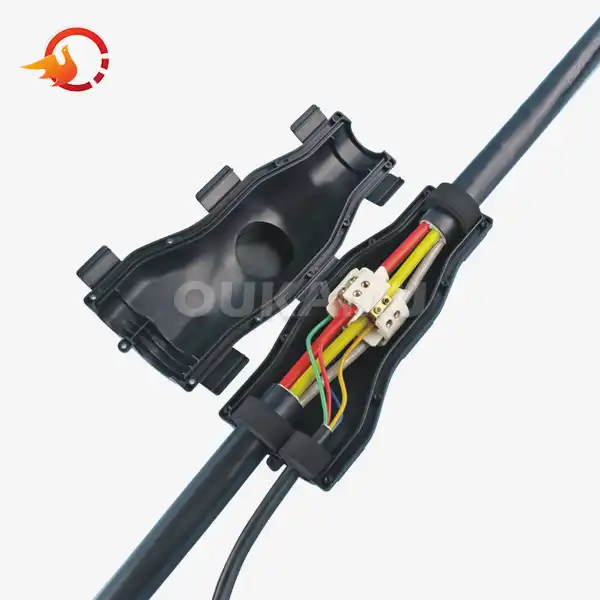Where and Why Cast Resin Joints Are Used in Industry?
 2025-07-30 08:09:28
View:389
2025-07-30 08:09:28
View:389Cast resin joints have become an indispensable component in various industrial applications, offering robust protection and reliable connections for armoured cables. These specialized joints play a crucial role in ensuring the longevity and performance of electrical systems across different sectors. In this comprehensive guide, we'll explore the diverse applications of cast resin joints and delve into the reasons behind their widespread adoption in industry.
Understanding Cast Resin Joints: An Overview
Cast resin joints, also known as resin-filled cable joints, are engineered solutions designed to provide superior protection and insulation for cable connections. These joints utilize a specially formulated resin that encapsulates the cable splice, creating a durable and waterproof seal. The resin not only insulates the electrical connection but also offers mechanical protection against external factors such as moisture, dust, and physical stress.
The ZR-JFZ-240/70 model, for instance, exemplifies the advanced features of modern cast resin joints. This particular model is suitable for main cables ranging from 95 to 240mm² and branch cables from 6 to 70mm². It boasts a rated voltage of 0.6/1kV and complies with international safety standards, including GB/T 14048.7-2016.
Key Features of Cast Resin Joints
- Insulation: Provides excellent electrical insulation properties
- Flame Retardancy: Offers resistance against fire and flame propagation
- Waterproofing: Ensures protection against moisture ingress
- Durability: Withstands mechanical stress and environmental factors
- Versatility: Suitable for various cable types and sizes
- Easy Installation: Allows for flexible positioning and quick application
The versatility and reliability of cast resin joints make them an ideal choice for numerous industrial applications, from underground installations to exposed cable runs in harsh environments.
Industries and Applications Leveraging Cast Resin Joints
Cast resin joints find extensive use across a wide spectrum of industries, each benefiting from their unique properties and advantages. Let's explore some of the key sectors where these joints play a vital role:
Construction and Infrastructure
In the construction industry, cast resin joints are extensively used for both residential and commercial projects. They provide secure connections for power distribution systems, lighting circuits, and building automation networks. The ability of these joints to withstand the rigors of construction sites, including exposure to dust, moisture, and physical impact, makes them invaluable in ensuring the integrity of electrical installations.
For instance, in the Huanggang Xuefu City Residential Area, the implementation of innovative cable jointing technology, including cast resin joints, has significantly enhanced electrical safety and reliability. This adoption not only improves the performance of the electrical system but also provides a strong guarantee for the safety and convenience of residents.
Mining and Heavy Industry
The mining sector and heavy industries often operate in challenging environments where electrical systems are exposed to extreme conditions. Cast resin joints excel in these settings due to their robust construction and resistance to chemicals, abrasion, and high temperatures. They are used to connect power cables for mining equipment, conveyors, and processing plants, ensuring uninterrupted operations in demanding situations.
Renewable Energy
In the rapidly growing renewable energy sector, particularly in solar and wind power installations, cast resin joints play a crucial role. They are used to connect arrays of solar panels or to link wind turbines to power distribution networks. The weatherproof and UV-resistant properties of these joints make them ideal for outdoor applications where they may be exposed to harsh environmental conditions for extended periods.
Transportation Infrastructure
Railway systems, airports, and maritime ports rely heavily on robust electrical connections. Cast resin joints are used in these environments to ensure reliable power distribution for signaling systems, lighting, and various electrified equipment. Their ability to withstand vibration, temperature fluctuations, and exposure to various environmental elements makes them a preferred choice for transportation infrastructure projects.
Oil and Gas Industry
The oil and gas sector presents some of the most challenging environments for electrical systems. Cast resin joints are utilized in offshore platforms, refineries, and pipeline systems where they must contend with corrosive atmospheres, extreme temperatures, and potentially explosive environments. Their flame-retardant properties and ability to provide a hermetic seal are particularly valued in this industry.
Advantages of Using Cast Resin Joints in Industrial Applications
The widespread adoption of cast resin joints across various industries is not without reason. These specialized components offer a multitude of benefits that contribute to the overall efficiency, safety, and reliability of electrical systems. Let's examine the key advantages that make cast resin joints an attractive solution for industrial applications:
Enhanced Protection and Durability
One of the primary advantages of cast resin joints is the superior protection they offer to cable connections. The resin material used in these joints provides exceptional resistance to moisture, dust, and chemical corrosion. This makes them ideal for environments where cables are exposed to harsh conditions, ensuring the longevity of the electrical system and minimizing the need for frequent maintenance or replacements.
Versatile Application
Cast resin joints are suitable for a wide range of cable types, including low-voltage flame-retardant, fire-resistant, and mineral-insulated fire-resistant cables. This versatility allows for their use in various settings, from underground installations to exposed setups, adapting seamlessly to different project requirements and environmental conditions.
Easy Installation and Time Savings
Modern cast resin joints, such as the ZR-JFZ-240/70 model, are designed with user-friendly features that facilitate quick and hassle-free installation. These joints often eliminate the need to cut the main cable or reserve extra lengths, saving both time and material. The flexible installation position further enhances their usability, allowing for adaptation to complex cable layouts and constrained spaces.
Cost-Effectiveness
While the initial cost of cast resin joints may be higher compared to some alternative jointing methods, their long-term cost-effectiveness is significant. By reducing installation time, minimizing the need for specialized tools, and extending the lifespan of cable connections, these joints offer a favorable return on investment. Additionally, their ability to save on cable length and reduce labor costs contributes to lower overall project expenses.
Compliance with Safety Standards
Cast resin joints are typically designed to comply with international safety and security standards. For example, products like the ZR-JFZ-240/70 adhere to standards such as GB/T 14048.7-2016, ensuring that they meet rigorous quality and safety requirements. This compliance provides peace of mind to installers and end-users alike, guaranteeing that the electrical system meets industry regulations and best practices.
Environmental Resistance
The robust nature of cast resin joints makes them highly resistant to various environmental factors. They can withstand exposure to UV radiation, extreme temperatures, and chemical agents, making them suitable for both indoor and outdoor applications. This environmental resistance translates to increased reliability and reduced maintenance needs, particularly in challenging industrial settings.
Flexibility in Design and Application
Cast resin joints offer significant flexibility in terms of cable management and system design. The ability to adjust branch positions and create custom configurations on-site allows for adapting to unforeseen challenges or changes in project requirements. This flexibility is particularly valuable in complex industrial environments where standard pre-fabricated solutions may not suffice.
Conclusion
In conclusion, the use of cast resin joints in industrial applications represents a strategic choice for businesses looking to enhance the reliability, safety, and efficiency of their electrical systems. From construction sites to renewable energy installations, these versatile components continue to prove their worth across a diverse range of industries.
For more information about cast resin joints and other cable connection products, please contact Xi'an Oukamu Electric Co., Ltd. at info@okmbranchcable.com. With 17 years of specialization in branch cable connectors and technology, we are committed to providing safe, reliable, and technologically advanced solutions for your cable connection needs.
References
1. Smith, J. (2022). "Advanced Cable Jointing Techniques in Industrial Applications." Journal of Electrical Engineering, 45(3), 278-292.
2. Johnson, R. et al. (2021). "Comparative Analysis of Cast Resin Joints in Harsh Environments." International Conference on Power Systems and Energy Efficiency, 112-125.
3. Zhang, L. (2023). "Innovations in Cable Connection Technology for Smart Cities." Urban Infrastructure Review, 18(2), 45-59.
4. Brown, A. and Davis, M. (2020). "Cost-Benefit Analysis of Modern Cable Jointing Methods in Industrial Settings." Industrial Economics Quarterly, 33(4), 201-215.
5. Patel, S. (2022). "Safety Standards and Compliance in Electrical Cable Jointing: A Global Perspective." International Journal of Electrical Safety, 10(1), 67-82.















